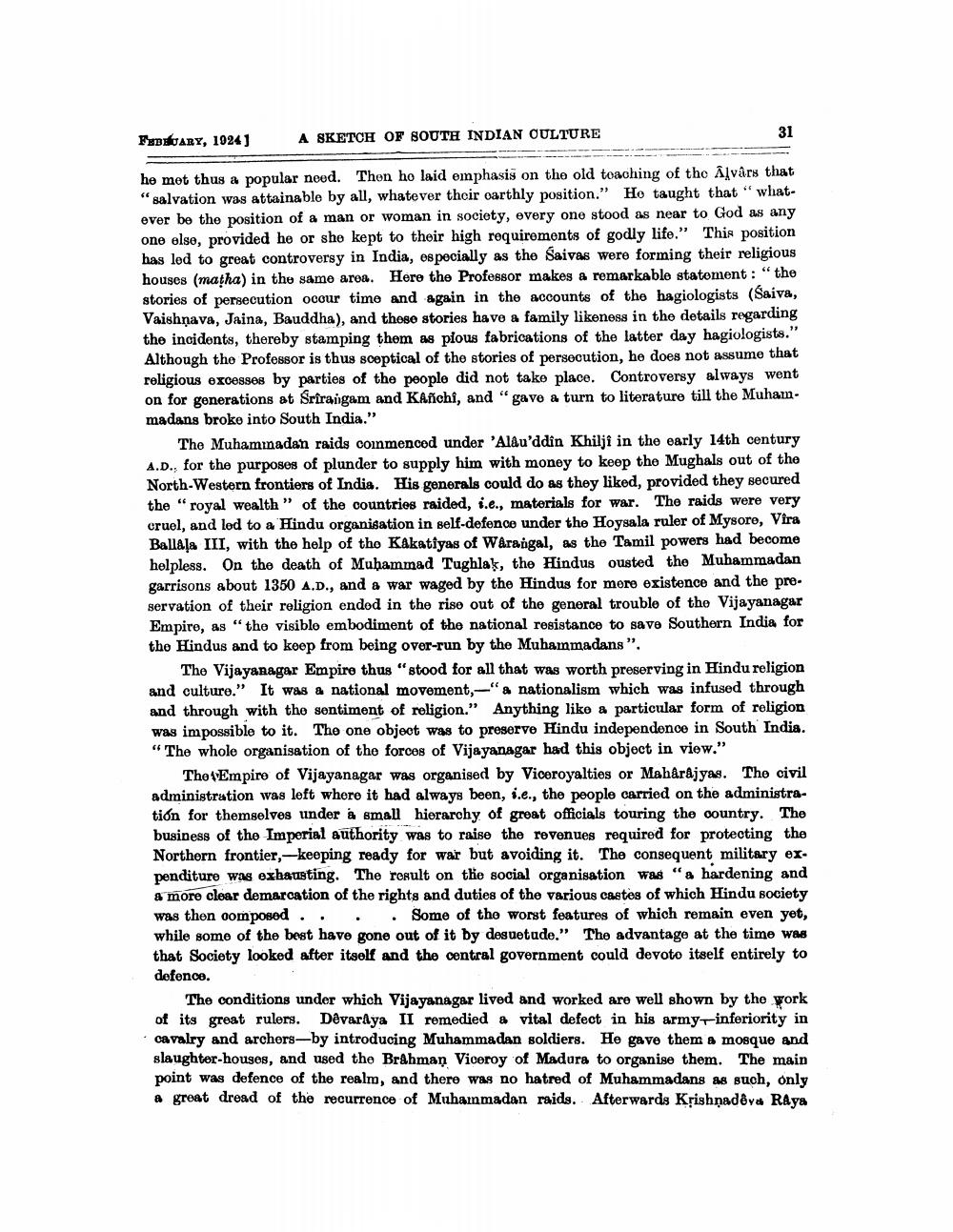________________
Fuary, 1024]
A SKETCH OF SOUTH INDIAN CULTURE
31
he met thus a popular need. Then ho laid emphasis on the old toaching of the Alvars that "salvation was attainable by all, whatever their oarthly position." He taught that "whatever be the position of a man or woman in society, every one stood as near to God as any one else, provided he or she kept to their high requirements of godly life." This position has led to great controversy in India, especially as the Saivas were forming their religious houses (matha) in the same aroa. Here the Professor makes a remarkable statoment: “the stories of persecution occur time and again in the accounts of the hagiologists (Saiva, Vaishnava, Jaina, Bauddha), and those stories have a family likeness in the details regarding the incidents, thereby stamping them as pious fabrications of the latter day hagiologists." Although the Professor is thus sceptical of the stories of persecution, he does not assume that religious excesses by parties of the people did not take place. Controversy always went on for generations at Srirangam and KAñchi, and " gave a turn to literature till the Muhammadans broke into South India."
The Muhammadan raids coinmenced under 'Alau'ddin Khilji in the early 14th century A.D., for the purposes of plunder to supply him with money to keep the Mughals out of the North-Western frontiers of India. His generals could do as they liked, provided they secured the "royal wealth" of the countries raided, i.e., materials for war. The raids were very cruel, and led to a Hindu organisation in self-defence under the Hoysala ruler of Mysore, Vira Ballaļa III, with the help of the Kakatiyas of Warangal, as the Tamil powers had become helpless. On the death of Muhammad Tughlak, the Hindus ousted the Muhammadan garrisons about 1350 A.D., and a war waged by the Hindus for mere existence and the preservation of their religion ended in the rise out of the general trouble of the Vijayanagar Empire, as "the visiblo embodiment of the national resistance to save Southern India for the Hindus and to keep from being over-run by the Muhammadans".
The Vijayanagar Empire thus "stood for all that was worth preserving in Hindu religion and culture." It was a national movement, -"& nationalism which was infused through and through with the sentiment of religion.” Anything like a particular form of religion was impossible to it. The one objeot was to preserve Hindu independence in South India. "The whole organisation of the forces of Vijayanagar had this object in view."
The Empire of Vijayanagar was organised by Viceroyalties or Maharajyas. The civil administration was left where it had always been, i.e., the people carried on the administratión for themselves under a small hierarchy of great officials touring the country. The business of the Imperial authority was to raise the revenues required for protecting the Northern frontier,-keeping ready for war but avoiding it. The consequent military ex. penditure was exhausting. The result on the social organisation was “a hardening and a more clear demarcation of the rights and duties of the various castes of which Hindu society was then composed . . . Some of the worst features of which remain even yet, while some of the best have gone out of it by desuetude." The advantage at the time was that Society looked after itself and the central government could devoto itself entirely to defence.
The conditions under which Vijayanagar lived and worked are well shown by the work of its great rulers. Dêvardya II remedied a vital defect in his army inferiority in cavalry and archors-by introducing Muhammadan soldiers. He gave them a mosque and slaughter-houses, and used the Brahman Viceroy of Madura to organise them. The main point was defence of the realm, and there was no hatred of Muhammadans as such, only a great dread of the recurrence of Muhammadan raids. Afterwards Krishnadeva Raya




